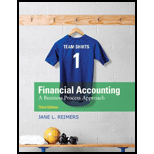
Financial Accounting
3rd Edition
ISBN: 9780133791129
Author: Jane L. Reimers
Publisher: Pearson Higher Ed
expand_more
expand_more
format_list_bulleted
Question
Chapter 7A, Problem 1YT
To determine
Compute the amount that should be deposit today to have $5,000 in five years at an annual interest rate of 10%.
Expert Solution & Answer
Explanation of Solution
Compute the present value of $5,000 in five years:
Therefore, the present value of $5,000 in the five years is $3,104.60.
Want to see more full solutions like this?
Subscribe now to access step-by-step solutions to millions of textbook problems written by subject matter experts!
Students have asked these similar questions
Lina purchased a new car for use in her business during 2024. The auto was the only business asset she purchased
during the year, and her business was extremely profitable. Calculate her maximum depreciation deductions (including
§179 expense unless stated otherwise) for the automobile in 2024 and 2025 (Lina doesn't want to take bonus
depreciation for 2024) in the following alternative scenarios (assuming half-year convention for all): (Use MACRS Table 1,
Table 2, and Exhibit 10-10.)
b. The vehicle cost $85,000, and business use is 100 percent.
Year
Depreciation
deduction
2024
2025
What adjusting journal entry should be recorded to account for the expiration of this asset on these financial accounting question?
Assume that ACW Corporation has 2024 taxable income of $1,720,000 for purposes of computing the §179 expense. The company
acquired the following assets during 2024 (assume no bonus depreciation): (Use MACRS Table 1, Table 2, and Table 5.)
Asset
Machinery
Placed in Service
September 12
Basis
$ 492,000
Computer equipment
Delivery truck
February 10
August 21
Qualified real property (MACRS, 15
year, 150% DB)
April 2
Total
92,000
115,000
1,402,000
$ 2,101,000
a. What is the maximum amount of §179 expense ACW may deduct for 2024?
b. What is the maximum total depreciation that ACW may deduct in 2024 on the assets it placed in service in 2024?
Note: Round your intermediate calculations and final answer to the nearest whole dollar amount.
a. Maximum §179 expense for 2024
b. Maximum total deductible depreciation for 2024
Chapter 7A Solutions
Financial Accounting
Ch. 7A - Prob. 1YTCh. 7A - Suppose Action Company issues a 1,000, 10-year,...Ch. 7A - Suppose HPS Company issues a 1,000 face value,...Ch. 7A - Present value. (LO 8). Suppose you want to have...Ch. 7A - Present value. (LO 8). Able Company has offered to...Ch. 7A - Calculate payments using time value of money...Ch. 7A - Calculate payments using time value of money...Ch. 7A - Prob. 5PACh. 7A - Prob. 6PB
Knowledge Booster
Similar questions
- Solve fastlyarrow_forwardWhat is the return on common stockholders equity for these financial accounting question?arrow_forwardEvergreen Corporation (calendar-year-end) acquired the following assets during the current year: (Use MACRS Table 1 and Table 2.) Date Placed in Asset Machinery Service October 25 Original Basis $ 120,000 Computer equipment February 3 47,500 Used delivery truck* August 17 Furniture April 22 60,500 212,500 The delivery truck is not a luxury automobile. Note: Do not round intermediate calculations. Round your answers to the nearest whole dollar amount. a. What is the allowable depreciation on Evergreen's property in the current year, assuming Evergreen does not elect §179 expense and elects out of bonus depreciation? Depreciation $ 69,096arrow_forward
- Nicole organized a new corporation. The corporation began business on April 1 of year 1. She made the following expenditures associated with getting the corporation started: Expense Date Amount Attorney fees for articles of incorporation February 10 $ 40,500 March 1-March 30 wages March 30 6,550 March 1-March 30 rent Stock issuance costs March 30 2,850 April 1-May 30 wages Note: Leave no answer blank. Enter zero if applicable. April 1 May 30 24,000 16,375 a. What is the total amount of the start-up costs and organizational expenditures for Nicole's corporation? Start-up costs Organizational expendituresarrow_forwardWhat is the return on investment of this financial accounting question?arrow_forwardLast Chance Mine (LCM) purchased a coal deposit for $2,918,300. It estimated it would extract 18,950 tons of coal from the deposit. LCM mined the coal and sold it, reporting gross receipts of $1.24 million, $13 million, and $11 million for years 1 through 3, respectively. During years 1-3, LCM reported net income (loss) from the coal deposit activity in the amount of ($11,400), $550,000, and $502,500, respectively. In years 1-3, LCM extracted 19,950 tons of coal as follows: (1) Tons of Coal 18,950 Depletion (2) Basis (2)(1) Rate $2,918,300 $154.00 Tons Extracted per Year Year 1 4,500 Year 2 8,850 Year 3 6,600 Note: Leave no answer blank. Enter zero if applicable. Enter your answers in dollars and not in millions of dollars. b. What is LCM's percentage depletion for each year (the applicable percentage for coal is 10 percent)? Percentage Depletion Year 1 Year 2 Year 3 $ 0arrow_forward
- Can you please solve this accounting issue without use Ai?arrow_forwardBrown Company estimates that monthly sales will be as follows. January $100,000 February 150,000 March 180,000 Historical trends indicate that 40 percent of sales are collected during the month of sale, 50 percent are collected in the month following the sale, and 10 percent are collected two months after the sale. Brown's accounts receivable balance as of December 31 totals $80,000 ($72,000 from December's sales and $8,000 from November's sales). The amount of cash Brown can expect to collect during the month of January is?arrow_forwardgiven answer General accounting questionarrow_forward
arrow_back_ios
SEE MORE QUESTIONS
arrow_forward_ios
Recommended textbooks for you
- Principles of Accounting Volume 2AccountingISBN:9781947172609Author:OpenStaxPublisher:OpenStax College

Principles of Accounting Volume 2
Accounting
ISBN:9781947172609
Author:OpenStax
Publisher:OpenStax College